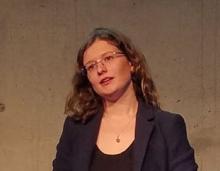BERLIN – Retinal thinning related to ganglion loss may be independent of optic neuritis attacks in patients with neuromyelitis optica spectrum disorders who have anti–aquaporin-4 antibodies.
These eyes exhibited an annual retinal volume loss of about 0.6 micrometers – 80 times higher than that of normal controls – even though they did not have a history of optic neuritis (ON), Frederike C. Oertel said at the annual congress of the European Committee for Treatment and Research in Multiple Sclerosis.
“The most likely explanation for this seems to be a disease-related primary retinopathy due to the high density of astrocytic cells in the retina and the afferent visual system,” said Ms. Oertel, a doctoral student at NeuroCure Clinical Research Center, Berlin.
The study appeared in the Journal of Neurology, Neurosurgery & Psychiatry (J Neurol Neurosurg Psychiatry. 2018 Jun 19. doi: 10.1136/jnnp-2018-318382).
A previous cross-sectional study by her group found retinal thinning and an alteration of foveal shape in anti–aquaporin-4 (anti-AQP4) positive patients with neuromyelitis optica spectrum disorders (NMOSD) independent of whether they had experienced a clinical attack of optic neuritis (Neurol Neuroimmunol Neuroinflamm. 2017 May;4[3]:e334). In these patients, the fovea changed shape from a characteristic steeply angled “V” to a broader, flatter “U” shape, she said.
In that 2017 paper, Ms. Oertel and her colleagues theorized that the relationship between the water-channel regulator AQP4 and astrocytes could be the root cause of these microstructural alterations.
“The parafoveal area is characterized by a high density of retinal astrocytic Müller cells, which express AQP4 and may thus serve as retinal targets in NMOSD,” they wrote. “Müller cells regulate the retinal water balance and have a relevant role in neurotransmitter and photopigment recycling, as well as in energy and lipid metabolism. Müller cell dysfunction or degeneration could thus lead to impaired retinal function including changes in water homeostasis. Of interest, both the initial cohort and the confirmatory cohort showed a mild increase of peripapillary retinal nerve fiber layer thickness, which could indicate tissue swelling. These findings are supported by animal studies showing retraction of astrocytic end feet in some and astrocyte death in other cases, suggesting a primary astrocytoma in NMOSD also outside acute lesions.”
The study Ms. Oertel presented at ECTRIMS looked at full retinal thickness using the same imaging tool, optical coherence tomography (OCT). The longitudinal cohort comprised 94 eyes in 51 anti–AQP4-IgG seropositive patients who had NMOSD; 60 of these eyes had experienced an optic neuritis attack and 34 had not. Most of the patients were female; the mean age was 47 years. They were compared against 28 age- and sex-matched healthy controls.
OCT measured combined ganglion cell and inner plexiform layer (GCIP), the peripapillary retinal nerve fiber layer (pRNFL), fovea thickness (FT), inner nuclear layer (INL), and total macular volume (TMV).
At baseline, ON eyes already displayed reduced GCIP, FT, and TMV, compared with healthy controls – but so had eyes that had not had ON. Over the follow-up period, eyes without ON continued to show thinning, even in the absence of a clinical attack. Although visual acuity didn’t change over time, the retinas continued to thin, losing an average of 0.6 micrometers each year, a rate 80 times greater than that seen in the control group.
“We saw this significant loss of the ganglion cell layer volume independent of ON, suggesting that retinal neurodegeneration is not dependent on ON in these patients,” Ms. Oertel said.
The results fit well into the group’s prior theory of astrocytic involvement. However, she added, “We still have to think about an alternative theory of drug-induced neuroaxonal damage and retrograde neuroaxonal degeneration.”
The project was supported with grants from the German Ministry for Education and Research. Ms. Oertel had no financial disclosures relevant to the work, but many coauthors reported financial relationships with industry.


